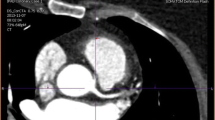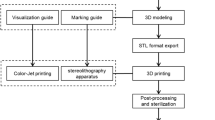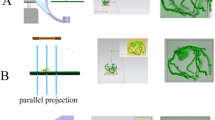Abstract
Purpose
To evaluate the accuracy and utility of a new image overlay system using a tablet PC for patients undergoing peripheral arterial reconstruction.
Methods
Eleven limbs treated with distal bypass surgery were studied. Three-dimensional images obtained by processing a preoperative contrast-enhanced computed tomography scan were superimposed onto the back-camera images of a tablet PC. We used this system to pinpoint a planned distal anastomotic site preoperatively and to make a precise incision directly above it during surgery. We used a branch artery near the distal anastomotic site as a reference point and the accuracy of the system was validated by comparing its results with the intraoperative findings. The precision of the system was also compared with that of a preoperative ultrasonographic examination.
Results
Both the image overlay system and ultrasonography (US) accurately identified the target branch artery in all except one limb. In that limb, which had a very small reference branch artery, preoperative US wrongly identified another branch, whereas the image overlay system located the target branch with an error of 10 mm.
Conclusions
Our image overlay system was easy to use and allowed us to precisely identify a target artery preoperatively. Therefore, this system could be helpful for pinpointing the most accurate incision site during surgery.




Similar content being viewed by others
References
Schurgin S, Rich S, Mazzone T. Increased prevalence of significant coronary artery calcification in patients with diabetes. Diabetes Care. 2001;24:335–8.
Ishimura E, Okuno S, Taniwaki H, Kizu A, Tsuchida T, Shioi A, et al. Different risk factors for vascular calcification in end-stage renal disease between diabetics and nondiabetics: the respective importance of glycemic and phosphate control. Kidney Blood Press Res. 2008;31:10–5.
Jager KA, Phillips DJ, Martin RL, Hanson C, Roederer GO, Langlois YE, et al. Noninvasive mapping of lower limb arterial lesions. Ultrasound Med Biol. 1985;11:515–21.
Elsman BH, Legemate DA, van der Heijden FH, de Vos HJ, Mali WP, Eikelboom BC. Impact of ultrasonographic duplex scanning on therapeutic decision making in lower-limb arterial disease. Br J Surg. 1995;82:630–3.
Wain RA, Berdejo GL, Delvalle WN, Lyon RT, Sanchez LA, Suggs WD, et al. Can duplex scan arterial mapping replace contrast arteriography as the test of choice before infrainguinal revascularization? J Vasc Surg. 1999;29:100–7 (discussion 107–9).
Luján S, Criado E, Puras E, Izquierdo LM. Duplex scanning or arteriography for preoperative planning of lower limb revascularisation. Eur J Vasc Endovasc Surg. 2002;24:31–6.
Mazzariol F, Ascher E, Hingorani A, Gunduz Y, Yorkovich W, Salles-Cunha S. Lower-extremity revascularisation without preoperative contrast arteriography in 185 cases: lessons learned with duplex ultrasound arterial mapping. Eur J Vasc Endovasc Surg. 2000;19:509–15.
de Vos MS, Bol BJ, Gravereaux EC, Hamming JF, Nguyen LL. Treatment planning for peripheral arterial disease based on duplex ultrasonography and computed tomography angiography: consistency, confidence and the value of additional imaging. Surgery. 2014;156:492–502.
Ascher E, Mazzariol F, Hingorani A, Salles-Cunha S, Gade P. The use of duplex ultrasound arterial mapping as an alternative to conventional arteriography for primary and secondary infrapopliteal bypasses. Am J Surg. 1999;178:162–5.
Karacagil S, Löfberg AM, Granbo A, Lörelius LE, Bergqvist D. Value of duplex scanning in evaluation of crural and foot arteries in limbs with severe lower limb ischaemia—a prospective comparison with angiography. Eur J Vasc Endovasc Surg. 1996;12:300–3.
Eiberg JP, Hansen MA. Grønvall Rasmussen JB, Schroeder TV. Minimum training requirement in ultrasound imaging of peripheral arterial disease. Eur J Vasc Endovasc Surg. 2008;36:325–30.
Chan D, Anderson ME, Dolmatch BL. Imaging evaluation of lower extremity infrainguinal disease: role of the noninvasive vascular laboratory, computed tomography angiography, and magnetic resonance angiography. Tech Vasc Interv Radiol. 2009;13:11–22.
Rassweiler JJ, Müller M, Fangerau M, Klein J, Goezen AS, Pereira P, et al. iPad-assisted percutaneous access to the kidney using marker-based navigation: initial clinical experience. Eur Urol. 2012;61:628–31.
Eguchi T, Takasuna K, Kitazawa A, Fukuzawa Y, Sakaue Y, Yoshida K, et al. Three-dimensional imaging navigation during a lung segmentectomy using an iPad. Eur J Cardiothorac Surg. 2012;41:893–7.
Anand M, King F, Ungi T, Lasso A, Rudan J, Jayender J, et al. Design and development of a mobile image overlay system for needle interventions. Conf Proc IEEE Eng Med Biol Soc. 2014;2014:6159–62.
Müller M, Rassweiler MC, Klein J, Seitel A, Gondan M, Baumhauer M, et al. Mobile augmented reality for computer-assisted percutaneous nephrolithotomy. Int J Comput Assist Radiol Surg. 2013;8:663–75.
Fukuda T, Matsuda H, Doi S, Sugiyama M, Morita Y, Yamada M, et al. Evaluation of automated 2D–3D image overlay system utilizing subtraction of bone marrow image for EVAR: feasibility study. Eur J Vasc Endovasc Surg. 2013;46:75–81.
Cabrilo I, Schaller K, Bijlenga P. Augmented reality-assisted bypass surgery: embracing minimal invasiveness. World Neurosurg. 2015;83:596–602.
Shuhaiber JH. Augmented reality in surgery. Arch Surg. 2004;139:170–4.
Inoue D, Cho B, Mori M, Kikkawa Y, Amano T, Nakamizo A, et al. Preliminary study on the clinical application of augmented reality neuronavigation. J Neurol Surg A Cent Eur Neurosurg. 2013;74:71–6.
Soler L, Delingette H, Malandain G, Montagnat J, Ayache N, Koehl C, et al. Fully automatic anatomical, pathological, and functional segmentation from CT scans for hepatic surgery. Comput Aided Surg. 2001;6:131–42.
Sato Y, Nakamoto M, Tamaki Y, Sasama T, Sakita I, Nakajima Y, et al. Image guidance of breast cancer surgery using 3-D ultrasound images and augmented reality visualization. IEEE Trans Med Imaging. 1998;17:681–93.
Okamoto T, Onda S, Yanaga K, Suzuki N, Hattori A. Clinical application of navigation surgery using augmented reality in the abdominal field. Surg Today. 2015;45:397–406.
Kamiuchi H, Masamune K. Medical image overlay system with a tablet PC and three markers. IEICE Tech Rep. 2012;112:29–34.
Jens S, Koelemay MJ, Reekers JA, Bipat S. Diagnostic performance of computed tomography angiography and contrast-enhanced magnetic resonance angiography in patients with critical limb ischaemia and intermittent claudication: systematic review and meta-analysis. Eur Radiol. 2013;23:3104–14.
Nakamura K, Miyazaki M, Kuroki K, Yamamoto A, Hiramine A, Admiraal-Behloul F. Noncontrast-enhanced peripheral MRA: technical optimization of flow-spoiled fresh blood imaging for screening peripheral arterial diseases. Magn Reson Med. 2011;65:595–602.
Author information
Authors and Affiliations
Corresponding author
Ethics declarations
Conflict of interest
Yasuaki Mochizuki and his co-authors have no conflicts of interest with regard to this study.
Rights and permissions
About this article
Cite this article
Mochizuki, Y., Hosaka, A., Kamiuchi, H. et al. New simple image overlay system using a tablet PC for pinpoint identification of the appropriate site for anastomosis in peripheral arterial reconstruction. Surg Today 46, 1387–1393 (2016). https://doi.org/10.1007/s00595-016-1326-4
Received:
Accepted:
Published:
Issue Date:
DOI: https://doi.org/10.1007/s00595-016-1326-4




